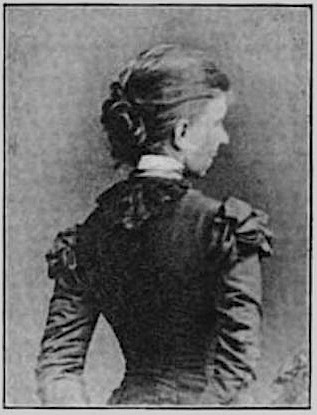This is M. H. Spielmann's account of Georgina Bowers (pp. 529-30) in his History of "Punch" (1895). Details of the book are given in the bibliography at the end. You may use the image without prior permission for any scholarly or educational purpose as long as you (1) credit the source and (2) link your document to this URL in a web document or cite the Victorian Web in a print one. [Click on the image to enlarge it.] — Jacqueline Banerjee

y far the most important lady artist who ever worked for Punch was Miss Georgina Bowers (for some years now Mrs. Bowers-Edwards).* It is not usual, as I have remarked before, to find a woman a professional humorist, though a colonial Punch is edited by a lady; but it is, I believe, an undoubted fact, that up to this year of grace no female caricaturist has yet appeared before man's vision. But Miss Bowers was a humorist, with very clear and happy notions as to what fun should be, and how it should be transferred to a picture.

From a photograph by S. A. Walker (Spielmann 529).
Her long career began in 1866, and thenceforward, working with undiminished energy, she executed hundreds of initials and vignettes as well as "socials," devoting herself in chief part to hunting and flirting subjects. She was a facile designer, but her manner was chronically weak. It was John Leech who set her on the track; Mark Lemon, to whom she took her drawings, encouraged her, and with help from Mr. Swain she progressed.
"My first published drawing," Miss Bowers tells me, "was a dreadful thing of a girl urging a muff of a man to give her a lead at a brook. My 'jokes' all came from [529/30] incidents I saw out hunting, and from my own varied adventures with horse and hound; but occasionally a suggestion sent to the Editor was transferred to me to be put into shape. Then some one else wrote up to them. When I first hunted in Hertfordshire, I had great opportunities for provincial sporting studies. I feel now that some of my subjects were too personal, and wonder how many people forgave me. I often overheard stories about myself in the hunting-field (where I had hard times with ladies occasionally). When Shirley Brooks died, I felt I had lost my best and most helpful friend; and then Mr. Tom Taylor cared nothing for sport or sporting subjects, so that I felt that my work was uncongenial to him, and I got on badly and lost all interest in it, and gave up, after having drawn ten years for the paper, to which I shall never again contribute."*The other ladies are Miss Coode, Mrs. Romer (Mrs. Jopling-Rowe), Mrs. Field, Miss Fraser, Miss Mansell (Mrs. Bull) — merely a sketch, and Miss Maud Sambourne.
Bibliography
Spielmann, Marion Harry. The History of "Punch". London: Cassell, 1895. Internet Archive. Contributed by the University of California. Web. 15 July 2017.
Created 15 July 2017